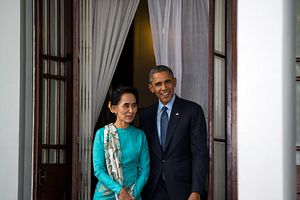WASHINGTON, D.C. – Despite the historic thawing of U.S.-Myanmar relations that has occurred under the Obama administration during its two terms in office, movement on defense ties has been quite slow. On Monday, after Myanmar’s ambassador to the United States Aung Lynn delivered an address at George Washington University, I asked him what his country would like to see from the incoming Donald Trump administration with respect to military-to-military relations in the wake of the uncertainty about Trump’s likely Asia policy (See: “What Will Donald Trump’s Asia Policy Look Like?”).
The Obama administration has invested significantly in engaging Myanmar after decades of isolation, restoring full diplomatic ties, removing economic sanctions, and boosting assistance to aid in the country’s reform efforts, which have been underway since 2011. Those reforms culminated in the country’s opposition, led by Aung San Suu Kyi, assuming power following a historic landslide election victory last November.
Yet despite the ongoing thaw in U.S.-Myanmar relations, movement on the defense side has been quite modest and there are still reservations by both sides on how they would proceed. This is despite the reality that engaging Myanmar’s military, or Tatmadaw – still by far the most powerful institution in the country – is central to ensuring that it plays a constructive role in the evolution of democracy and human rights, rule of law, and civil-military relations in the country and that it has more opportunities to engage Western countries instead of remaining overdependent on existing partners like China. This is something that officials in Myanmar, including Suu Kyi herself, have grown to accept.
Current efforts have focused on things like exchanges, outreach, professionalization, and supporting participation in multilateral engagements, with key developments including visits by senior officials, involvement by military and civilian officials in workshops on areas like human rights, and the integration of Myanmar as an observer in Cobra Gold, Asia’s largest annual multinational military exercise, held in Thailand. But there is still a long way to go just to get ties back to where they were before the freezing of U.S. military assistance in 1988 after the military violently suppressed civilian protests in Myanmar. In years prior, Myanmar has been part of U.S. military education and training programs and there was bilateral cooperation between the two militaries in areas such as counter-narcotics.
When I asked Aung Lynn, Myanmar’s envoy to the United States, what he would like to see in bilateral defense ties, his response focused on two things. The first was Myanmar’s restoration to the International Military Education and Training (IMET) program, a key tool for Washington to help engage and educate foreign militaries in areas like professionalism, civil-military relations, and democracy. “This is the program we wish to see more,” he said.
There are lingering, legitimate concerns about even restoring previous programs like IMET, some of them tied to broader concerns on the military’s role in human rights violations and others focused more specifically on IMET itself, including its effectiveness as a policy instrument in a cash-strapped environment. But it is also true that within a broader, calibrated strategy of engaging Myanmar’s military, IMET is low-hanging fruit ripe for the picking.
The second area Aung Lynn emphasized was Myanmar’s growing involvement in U.S. defense workshops. As an example, he noted the case of the just-concluded four-day annual workshop on humanitarian and disaster relief organized by U.S. Army Pacific. The engagement, called the Lower Mekong Initiative and Disaster Response Exercise and Exchange (DREE), kicked off on December 6 in Myanmar and is meant to promote integrated regional cooperation between mainland Southeast Asian states that fall under the U.S.-led Lower Mekong Initiative.
“Maybe this is a good beginning we can do more of in the future,” he said.
Facilitating Naypyidaw’s involvement in such engagements is important for U.S. policy because it facilitates its integration into what U.S. Defense Secretary Ash Carter calls the principled and inclusive security network in the Asia-Pacific (See: “US Hits Right Note at Shangri-La With Principled Security Network”). And besides being good for the United States and Myanmar, this is also a positive for the region more generally since it would lead to the country playing a more active and constructive role in shared challenges in areas like HADR.
To be sure, there is much more that both the United States and Myanmar can do in the defense realm, from integrating Naypyidaw into U.S. exercises to boosting collaboration in areas like maritime security. Much of this will depend on how things evolve in the U.S. side, including where Myanmar fits in the hierarchy of the Trump administration’s Asia priorities, the relationship between the executive branch, Congress, and other influential civil society and democracy groups, and developments on key areas of U.S. concern, such as the Rohingya issue. But as these trends play themselves out, the next steps for U.S.-Myanmar defense cooperation remain clear to those who wish to see more of it.

































